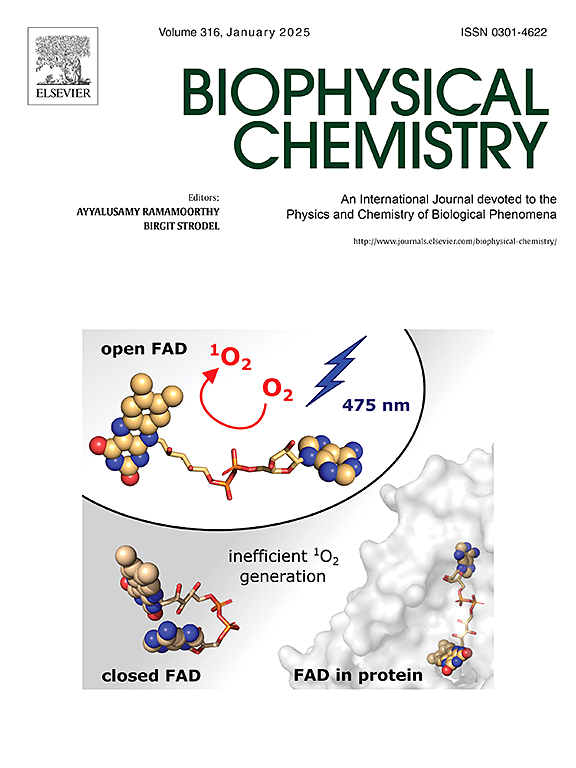Molecular crowding effect on specific binding of Hg2+ to T–T mismatched base pair in duplex DNA
IF 2.2
3区 生物学
Q2 BIOCHEMISTRY & MOLECULAR BIOLOGY
引用次数: 0
Abstract
Many biomolecules are crowded in vivo environments. Metal ion–nucleic acid interactions are important in vivo molecular crowding conditions for structure formation and biological activity of nucleic acids. Although metal ion–nucleic acid interactions have been investigated in detail under diluted conditions, studies examining the molecular crowding effect on metal ion–nucleic acid interactions are limited. Hg2+ specifically binds to T–T mismatched duplex DNA to form T–Hg–T base pair under diluted conditions. Here, we examined the binding under molecular crowding conditions. To the best of our knowledge, no previous studies reported the metal-mediated base-pair formation under molecular crowding conditions. UV melting showed that the specific stabilization of only the T–T mismatched duplex by Hg2+ addition was maintained under molecular crowding conditions. CD spectra showed that no significant structural change of the T–T mismatched duplex by Hg2+ addition was preserved under molecular crowding conditions. Isothermal titration calorimetric analyses showed that the 1:1 M ratio for the specific binding of Hg2+ to T–T was maintained under molecular crowding conditions. However, the magnitudes of the negative ∆H and the positive ∆S were significantly larger and smaller, respectively, than those under diluted conditions, which may lead to the smaller magnitudes of Ka and ∆G. Smaller number of released water molecules upon the binding under molecular crowding conditions may result in these results. The present findings may be useful for developing efficient metal-mediated base-pair formation, leading to progress in their efficient applications in various fields including nanotechnology.

双链DNA中Hg2+与T-T错配碱基对特异性结合的分子拥挤效应
许多生物分子在体内环境中是拥挤的。金属离子-核酸相互作用是核酸结构形成和生物活性的重要分子拥挤条件。虽然在稀释条件下已经详细研究了金属离子-核酸相互作用,但研究分子拥挤效应对金属离子-核酸相互作用的影响是有限的。Hg2+在稀释条件下特异性结合T-T错配双链DNA形成T-Hg-T碱基对。在这里,我们研究了分子拥挤条件下的结合。据我们所知,以前没有研究报道过在分子拥挤条件下金属介导的碱基对形成。紫外熔融表明,在分子拥挤条件下,Hg2+的加入只维持了T-T错配双相的特异性稳定。CD光谱显示,在分子拥挤条件下,Hg2+的加入对T-T错配双相的结构没有明显的影响。等温滴定量热分析表明,在分子拥挤条件下,Hg2+与T-T的特异性结合保持1:1的M比。然而,与稀释条件下相比,负∆H和正∆S的幅度分别明显较大和较小,这可能导致Ka和∆G的幅度较小。在分子拥挤条件下,结合时释放的水分子数量较少可能导致这些结果。本研究结果可能有助于开发高效的金属介导的碱基对形成,从而导致其在包括纳米技术在内的各个领域的有效应用取得进展。
本文章由计算机程序翻译,如有差异,请以英文原文为准。
求助全文
约1分钟内获得全文
求助全文
来源期刊

Biophysical chemistry
生物-生化与分子生物学
CiteScore
6.10
自引率
10.50%
发文量
121
审稿时长
20 days
期刊介绍:
Biophysical Chemistry publishes original work and reviews in the areas of chemistry and physics directly impacting biological phenomena. Quantitative analysis of the properties of biological macromolecules, biologically active molecules, macromolecular assemblies and cell components in terms of kinetics, thermodynamics, spatio-temporal organization, NMR and X-ray structural biology, as well as single-molecule detection represent a major focus of the journal. Theoretical and computational treatments of biomacromolecular systems, macromolecular interactions, regulatory control and systems biology are also of interest to the journal.
 求助内容:
求助内容: 应助结果提醒方式:
应助结果提醒方式:


